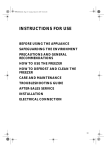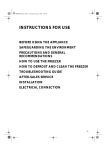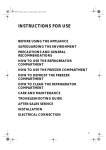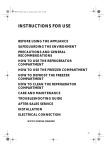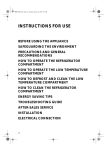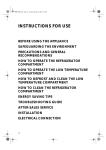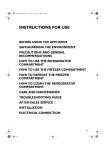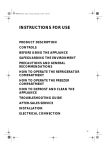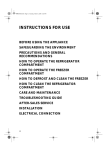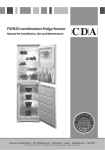Download Whirlpool ARG 645 A Troubleshooting guide
Transcript
30802003GB.fm Page 3 Monday, December 19, 2005 12:18 PM INSTRUCTIONS FOR USE BEFORE USING THE APPLIANCE SAFEGUARDING THE ENVIRONMENT PRECAUTIONS AND GENERAL RECOMMENDATIONS HOW TO OPERATE THE REFRIGERATOR COMPARTMENT HOW TO USE THE FREEZER COMPARTMENT HOW TO DEFROST THE APPLIANCE CARE AND MAINTENANCE TROUBLESHOOTING GUIDE / AFTER-SALES SERVICE AFTER-SALES SERVICE INSTALLATION ELECTRICAL CONNECTION 3 Downloaded from Fridge-Manual.com Manuals 30802003GB.fm Page 4 Monday, December 19, 2005 12:18 PM BEFORE USING THE APPLIANCE • Your new appliance is designed exclusively for domestic use To get the most out of your new appliance, read the user handbook thoroughly. The handbook contains a description of the appliance and useful tips for storing food. Keep this handbook for future consultation. 1. After unpacking, make sure that the appliance is undamaged and that the door closes properly. Any damage must be reported to your dealer within 24 hours after delivery of the appliance. 2. Wait at least two hours before switching the appliance on in order to ensure the refrigerant circuit is fully efficient. 3. Installation of the appliance and electrical connections must be carried out by a qualified electrician, in accordance with the manufacturer’s instructions and local safety regulations 4. Clean the inside of the appliance before using it. SAFEGUARDING THE ENVIRONMENT 1. Packing The packaging material is entirely recyclable, and marked with the recycling symbol. Follow local regulations for scrapping. Keep the packaging materials (plastic bags, polystyrene parts, etc.) out of reach of children, as they are potentially dangerous. 2. Scrapping The appliance is manufactured using recyclable material. This appliance is marked according to the European directive 2002/96/EC on Waste Electrical and Electronic Equipment (WEEE). By ensuring this product is disposed of correctly, you will help prevent potential negative consequences for the environment and human health, which could otherwise be caused by inappropriate waste handling of this product. The symbol on the product, or on the documents accompanying the product, indicates that this appliance may not be treated as household waste. Instead it shall be handed over to the applicable collection point for the recycling of electrical and electronic equipment. Before scrapping, make the appliance unusable by cutting off the power cable and removing the doors and shelves so that children cannot easily climb inside the appliance. Disposal must be carried out in accordance with local environmental regulations for waste disposal. Deliver the appliance immediately to an authorized dump; do not leave it unattended even for a few days, since it is potentially dangerous for children. For more detailed information about treatment, recovery and recycling of this product, please contact your local city office, your household waste disposal service or the shop where you purchased the product. 4 Downloaded from Fridge-Manual.com Manuals Information: This appliance does not contain CFCs (replaced with R134a) or HFCs (replaced with R600a). Appliances with Isobutane (R600a): isobutane is a naturally occurring, low environmental impact gas. Caution is required, however, because isobutane is flammable. Therefore, it is essential to ensure that refrigerant pipelines are not damaged. Declaration of conformity • This appliance is designed to store food and is manufactured in conformity with European Directive 90/128/EEC, 02/72/EEC and Regulation (EC) No. 1935/2004 • This appliance is designed, manufactured, and retailed in compliance with: - the safety objectives of the Low Voltage Directive 73/23/EEC; - the protection requirements of the “EMC” Directive 89/336/EEC, amended by Directive 93/68/EEC. • The electrical safety of the appliance can only be guaranteed if the product is connected to an approved earth connection. 30802003GB.fm Page 5 Monday, December 19, 2005 12:18 PM PRECAUTIONS AND GENERAL RECOMMENDATIONS • Use the refrigerator compartment only for storing fresh food and beverages and use the freezer compartment only for storing frozen food, freezing fresh food and making ice cubes. • After installation, make sure that the appliance is not standing on the power supply cable. • Do not store glass containers with liquids in the freezer since they may burst. • Do not eat ice cubes or ice lollies immediately after taking them out of the freezer since they may cause cold burns. • Before carrying out any maintenance or cleaning, always unplug the appliance or disconnect the power supply. • Make sure that the appliance is not near a heat source. • Do not store or use gasoline or other flammable vapours and liquids in the vicinity of this or any other appliance. The fumes can create a fire hazard or explosion. • To ensure proper ventilation leave a space on both sides and at the top of the refrigerator. • Ensure that the vent outlets on the appliance casing or housing unit are unobstructed in order to allow correct air circulation. • All appliances equipped with an ice maker or water dispenser must be connected to a mains water supply that delivers potable water only (with water pressure between 1.7 and 8.1 bar (25 and 117 PSI)). Ice makers and/ or water dispensers not directly connected to a mains water supply must be filled with potable water only. • Install and level the appliance on a floor strong enough to take its weight and in an area suitable for its size and use. • Install the appliance in a dry and wellventilated place. The appliance is set for operation at specific ambient temperature ranges, according to the climatic class indicated on the data plate: The appliance may not work properly if it is left for a long period at a temperature above or below the indicated range. Climatic class SN N ST T Amb. T. (°C) From 10 to 32 From 16 to 32 From 18 to 38 From 18 to 43 Amb. T. (°F) From 50 to 90 From 61 to 90 From 64 to 100 From 64 to 110 • Be careful not to damage the floors when you move the appliance (e.g. parquet flooring). • Do not use mechanical devices or any means other than those recommended by the manufacturer to speed up the defrosting process. • Do not damage the refrigerant circuit. • Do not use electrical appliances inside the freezer compartments, unless such appliances are specifically recommended by the manufacturer. • This appliance is not designed for use by young children or the infirm. • To avoid the risk of children being trapped and therefore suffocating, do not allow them to play or hide inside the appliance. • The power cable may only be replaced by an authorized person. • Do not use extension leads or adapters. • It must be possible to disconnect the appliance from the mains by unplugging it or by means of a two-pole switch fitted upline of the socket. • Ensure that the voltage indicated on the appliance data plate corresponds to the domestic supply voltage • Do not swallow the contents (non-toxic) of the ice packs (if provided). 5 Downloaded from Fridge-Manual.com Manuals 30802003GB.fm Page 6 Monday, December 19, 2005 12:18 PM HOW TO OPERATE THE REFRIGERATOR COMPARTMENT Switching on the appliance 1. Plug in the appliance. 2. The appliance switches on. The temperature is factory set to 5 °C. An acoustic alarm sounds if the door is left open for more than 2 minutes (see section “Refrigerator door open alarm” in this chapter). Temperature adjustment for refrigerator compartment To adjust the temperature in the refrigerator compartment, proceed as follows: • press button (A) to increase the temperature; • press button (A) to lower the temperature. Note: Room temperature, frequency of door opening, the introduction of hot food and incorrect positioning of the appliance can affect the internal temperature of the refrigerator, which may differ from that indicated on the panel. Switching off the appliance If the appliance is not to be used for a prolonged period, it can be switched off by pressing button (C). Although connected to the power supply, the appliance is effectively deactivated, with the interior light switched off and all LEDs off except the red LED associated with button (C). To switch the appliance on again, press button (C). Refrigerator door open alarm If the refrigerator door is left open accidentally, the appliance issues a warning by means of the interior intermittent light. When the door has been left open for 2 minutes the light begins to blink. It will stop blinking when the door is closed. How to use the refrigerator compartment Position the food as shown in the figure: A Cooked food B Fish, meat C Fruit and vegetables D Cheese E Bottles Notes: • The space between the shelves and the rear wall of the refrigerator compartment must be unobstructed to allow circulation of air. • Do not place food in direct contact with the rear wall of the refrigerator compartment. • Do not place hot food in the refrigerator. • Store liquids in closed containers. Important • Storing vegetables with high water content can cause condensation to form in the crisper: this will not affect the correct operation of the appliance. 6 Downloaded from Fridge-Manual.com Manuals 30802003GB.fm Page 7 Monday, December 19, 2005 12:18 PM HOW TO USE THE FREEZER COMPARTMENT The freezer compartment can be used for freezing fresh food. The quantity of fresh food that can be frozen in 24 hours is shown on the rating plate. Freezing fresh food • Press the freeze button D; the yellow LED comes on and remains lit for the entire period. • If your appliance is equipped with a grid, position food to be frozen as indicated in Fig. 1, otherwise position food as illustrated in Fig. 2. A Arrange the fresh food on the grid, leaving sufficient space around each pack for the air to circulate and avoiding contact with already frozen food (Fig.1). B Arrange the food centrally in the compartment , ensuring it does not come into contact with already frozen food. Leave a space of approx. 20 mm around packages (Fig. 2). • After approximately 24 hours the function switches off automatically and the yellow LED for button D switches off. To cancel the function, press button D again. Fig. 1 Fig. 2 When purchasing frozen food products: • Ensure that the packaging is not damaged (frozen food in damaged packaging may have deteriorated). If the package is swollen or has damp patches, it may not have been stored under optimal conditions and defrosting may have already begun. • When shopping, leave frozen food purchases until last and transport the products in a thermally insulated cool bag. • Place the items in the compartment as soon as you get home. • If food has defrosted even partially, do not re-freeze it. Consume within 24 hours. • Avoid, or reduce temperature variations to the minimum. Respect the best-before date on the package. • Always observe the storage information on the package. Making ice cubes • Fill the ice cube tray 2/3 full and place it in the compartment . • Do not use sharp or pointed instruments to detach the tray if it is stuck to the freezer bottom . • Bend the ice tray slightly to remove the cubes. The table alongside shows the recommended maximum storage time for frozen fresh foods. MONTHS FOOD 7 Downloaded from Fridge-Manual.com Manuals 30802003GB.fm Page 8 Monday, December 19, 2005 12:18 PM HOW TO DEFROST THE APPLIANCE Before defrosting, unplug the appliance from the mains or disconnect the electrical power supply. Defrosting of the refrigerator compartment is completely automatic. Droplets of water on the rear wall of the refrigerator compartment indicate that the periodic automatic defrost cycle is in progress. The defrost water is automatically routed to a drain outlet and into a container from which it evaporates. Clean the defrost water drain outlet regularly using the tool supplied with the appliance in order to ensure defrost water is removed correctly. Defrosting the compartment Defrost the compartment once or twice a year or when the ice formation is excessive. It is perfectly normal for ice to form. The amount and speed at which the ice forms depends on ambient conditions and the frequency with which the door is opened. Ice formation is concentrated at the top of the compartment and does not affect the efficiency of the appliance. If possible, defrost the freezer when it is nearly empty. • To switch off the freezer compartment, press button C. • Remove the food from the freezer compartment and group together in a cool place or in a cool bag. • Leave the door open to allow the frost to melt. • Clean the interior with a sponge soaked in warm water and/or neutral detergent. Do not use abrasive substances. • Rinse the interior and dry thoroughly. • Put the food back into the freezer. • Close the door. Plug in the appliance again and switch on following the instructions in chapter “How to operate the refrigerator compartment”: Adjustments and selections valid before switching off will automatically be restored. CARE AND MAINTENANCE Before any cleaning or maintenance operation, unplug the appliance from the mains or disconnect the electrical power supply. • Periodically clean the inside of the refrigerator compartment with a sponge dampened in warm water and/ or neutral detergent. Rinse and dry with a soft cloth. Do not use abrasive products. • The separators must not be washed with water but cleaned with a slightly damp sponge. • Clean the inside of the freezer compartment when defrosting. • Periodically clean air vents and the condenser at the rear of the appliance with a vacuum cleaner or a brush. • Clean the outside with a soft damp cloth. Do not use abrasive products, scourers, stain-removers (e.g. acetone, trichloroethylene) or vinegar. Prolonged disuse 1. Empty the refrigerator. 2. Disconnect the appliance from the power supply. 3. Defrost and clean the interior. 4. Clean the appliance. Leave the doors open to prevent the formation of mould, odours and oxidation. 8 Downloaded from Fridge-Manual.com Manuals 30802003GB.fm Page 9 Monday, December 19, 2005 12:18 PM TROUBLESHOOTING GUIDE / AFTER-SALES SERVICE When you hear these noises ..your appliance is alive!!! • Is there a power failure? 3. Water collects at the bottom of the refrigerator compartment. • Is the plug properly inserted in the socket? • • Is the double-pole switch on? 4. The inside light is not working. Perform the checks for problem 1., then: 1. The appliance is not working. • Has the fuse blown? • Is the power cord damaged? • 2. Temperature inside the compartments is not low enough. • Are the doors closed properly? Is the defrost water drain blocked? Disconnect the appliance from the mains power supply. To replace the bulb (max 25 W), refer to the instructions and illustration on the product description sheet. • Is the appliance installed near a heat source? 5. Excessive frost build-up in the freezer compartment. • Are the air circulation vents blocked? • Is the door shut properly? • Is food obstructing proper door closure? Gurgling and hissing noises due to expansion in the refrigerant circuit are normal. 9 Downloaded from Fridge-Manual.com Manuals 30802003GB.fm Page 10 Monday, December 19, 2005 12:18 PM AFTER-SALES SERVICE Before contacting After-Sales Service: 1. See if you can solve the problem yourself with the help of the Trouble-shooting guide. 2. Switch the appliance on again to see if the problem has been solved. If it has not, disconnect the appliance from the power supply and wait for about an hour before switching on again. 3. If the problem persists after this course of action, contact After-sales Service. • • • • • Specify: the nature of the problem the model the Service number (the number after the word SERVICE on the rating plate on the inside of the appliance) your full address your telephone number and area code Note: The direction of door opening can be changed. If this operation is performed by After-sales Service it is not covered by the warranty. INSTALLATION • • Install the appliance away from heat sources. Installation in a hot environment, direct exposure to the sun or installation near heat sources (heaters, radiators, cookers) will increase power consumption and should therefore be avoided. If this is not possible, the following minimum distances must be respected: Electrical connection • Electrical connections must be made in accordance with local regulations. • Voltage and power consumption are indicated on the rating plate inside the appliance. • Regulations require that the appliance is earthed. The Manufacturer declines all liabilities for injury to persons or animals or damage to property resulting from failure to observe these regulations. • If the plug and socket are not of the same type, have the socket replaced by a qualified electrician. • Do not use extension leads or adapters. •30 cm from coal or paraffin stoves; •3 cm from electric and/or gas stoves. • • Fit the spacers (if supplied) on the rear of the condenser positioned at the back of the appliance. Install the appliance in a dry, well-ventilated place, and ensure it is level, using the front adjustment feet if necessary. • Clean the interior. • Fit the accessories. 10 Downloaded from Fridge-Manual.com Manuals Disconnecting the appliance It must be possible to disconnect the appliance by unplugging it or by means of a two-pole switch fitted upline of the socket. 30802003GB.fm Page 11 Monday, December 19, 2005 12:18 PM ELECTRICAL CONNECTION 1) For Great Britain only Warning - this appliance must be earthed Fuse replacement If the mains lead of this appliance is fitted with a BS 1363A 13amp fused plug, to change a fuse in this type of plug use an A.S.T.A. approved fuse to BS 1362 type and proceed as follows: 1. Remove the fuse cover (A) and fuse (B). 2. Fit replacement 13A fuse into fuse cover. 3. Refit both into plug. Important: The fuse cover must be refitted when changing a fuse and if the fuse cover is lost the plug must not be used until a correct replacement is fitted. Correct replacement are identified by the colour insert or the colour embossed in words on the base of the plug. Replacement fuse covers are available from your local electrical store. 2) For the Republic of Ireland only The information given in respect of Great Britain will frequently apply, but a third type of plug and socket is also used, the 2-pin, side earth type. 3) Socket outlet / plug (valid for both countries) If the fitted plug is not suitable for your socket outlet, please contact Whirlpool Service for further instruction. Please do not attempt to change plug yourself. This procedure needs to be carried out by a qualified Whirlpool technician in compliance with the manufactures instructions and current standard safety regulations. 11 Downloaded from Fridge-Manual.com Manuals









